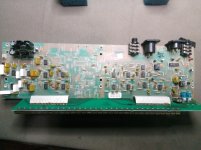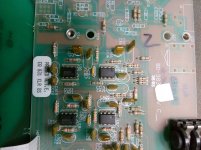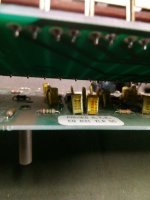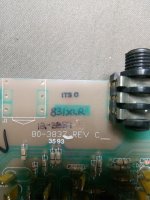Hi guys.
I have an older DOD 831 Series II graphic equalizer that induces noise (shhh) as soon as I increase or decrease any frequency band, the more I move the fader the more noise comes out.
Any Idea of what might be happening?
And I cannot find any service manual for this EQ online.
Thanks in advance.
I have an older DOD 831 Series II graphic equalizer that induces noise (shhh) as soon as I increase or decrease any frequency band, the more I move the fader the more noise comes out.
Any Idea of what might be happening?
And I cannot find any service manual for this EQ online.
Thanks in advance.
Where exactly in the signal chain is this EQ located?
There is no such thing as a perfectly noiseless EQ, especially an older one, which makes it important to get the levels right. This is a line level device and should ideally be located ahead of the master volume control, or at least ahead of a power amp with input trim. Your wanted signal should be lighting up the 0 dB LED in the level indicator on a regular basis.
This thread gives some hints. The mentioned FET bypass stage is likely to be the reason why no noise is to be heard until at least one fader is moved from the 0 dB position. Apparently there is some tweaking potential left in the EQ circuit, too, as several stock resistor values appear to be a bit on the high side for best noise and distortion performance.
I don't get what he writes about 60 Hz leakage... might be some non-ideal grounding going on there, or plain electrostatic coupling into the EQ circuitry from the transformer.
Check XLR pin 1 wiring for AES48-2005 compliance in any case (pin 1 direct to chassis).
There is no such thing as a perfectly noiseless EQ, especially an older one, which makes it important to get the levels right. This is a line level device and should ideally be located ahead of the master volume control, or at least ahead of a power amp with input trim. Your wanted signal should be lighting up the 0 dB LED in the level indicator on a regular basis.
This thread gives some hints. The mentioned FET bypass stage is likely to be the reason why no noise is to be heard until at least one fader is moved from the 0 dB position. Apparently there is some tweaking potential left in the EQ circuit, too, as several stock resistor values appear to be a bit on the high side for best noise and distortion performance.
I don't get what he writes about 60 Hz leakage... might be some non-ideal grounding going on there, or plain electrostatic coupling into the EQ circuitry from the transformer.
Check XLR pin 1 wiring for AES48-2005 compliance in any case (pin 1 direct to chassis).
Last edited:
I figured it out. This device is designed for 230V, and here we have 115V. After the rectifying bridge, there were +/- 10 VDC, and that's not enough for the 7815 and 7915 regulators. Then I noticed this tiny but very useful sticker above the AC input. It says 230V.........
Thanks to everyone for your effort.
Thanks to everyone for your effort.
That's another problem to be sorted out, of course, but I'd think this would primarily result in excessive mains (100/120 Hz) hum. Did you hear any? The actual EQ circuit would still be likely to operate more or less normally on ca. +/-8 V, though all bets are off when it comes to which aspects of its performance are going to suffer.
So I wouldn't necessarily put my bets on the noise issue being solved with a step-up transformer. It might, it might not.
So I wouldn't necessarily put my bets on the noise issue being solved with a step-up transformer. It might, it might not.
Oh, good to know then.
Oktoberfest is already over, I think... in late September I always see lots of folks in traditional Bavarian outfits on the train when heading to our main office, which is in the same direction as Munich. Never been there myself. Supposedly it's very very busy... not my cuppa.
We did just have our national holiday today, err, yesterday by now. The fall of the Berlin Wall was almost 30 years ago now, believe it or not.
Oktoberfest is already over, I think... in late September I always see lots of folks in traditional Bavarian outfits on the train when heading to our main office, which is in the same direction as Munich. Never been there myself. Supposedly it's very very busy... not my cuppa.
We did just have our national holiday today, err, yesterday by now. The fall of the Berlin Wall was almost 30 years ago now, believe it or not.
I know, I made an apprenticeship in Remscheid at the time and saw the whole thing on TV. Einen Strauss Bananen, 100 DM für jeden Ostdeutschen (ich sag extra nicht Ossi!), Trabbis überall, usw.
I checked the EQ again today and noticed that the 1.25k frequency in particular is the one that induces the noise. There is something that looks like a polyester cap but say "133H / 100V" on one side (no idea what this marking means) , followed by a 1K ohm resistor and one side of an 4558 op-amp. I'm not such a good electrician as to figuring it out right away. Could you give me a hint, maybe?
I checked the EQ again today and noticed that the 1.25k frequency in particular is the one that induces the noise. There is something that looks like a polyester cap but say "133H / 100V" on one side (no idea what this marking means) , followed by a 1K ohm resistor and one side of an 4558 op-amp. I'm not such a good electrician as to figuring it out right away. Could you give me a hint, maybe?
Then you must be about a decade older than me. How'd you end up in Venezuela of all places?I know, I made an apprenticeship in Remscheid at the time and saw the whole thing on TV.
I'm not exactly an expert on EQs but would check for dry joints on Rs and Cs involved in this range, and check whether the resistor hasn't gone high or maybe even a cap gone open (as rare as it is).I checked the EQ again today and noticed that the 1.25k frequency in particular is the one that induces the noise. There is something that looks like a polyester cap but say "133H / 100V" on one side (no idea what this marking means) , followed by a 1K ohm resistor and one side of an 4558 op-amp. I'm not such a good electrician as to figuring it out right away. Could you give me a hint, maybe?
133H is 13 nF, 3% tolerance. (133 = 13*10³ pF, H = 3%) 100V is the voltage rating.
The schematics of EQs I've seen had one opamp and a lot of RCs. Is this also the case here or is it a fancier circuit using one OP per band? Unfortunately I can't remember for my life what make/model they would have been, otherwise I would have looked it up. Ah, looks like Yamaha had a bunch. Probably not a great deal of variation between models. I imagine you could replace the transistors with opamps.
If that's not it, maybe it's more like ESP P64 or P75.
Mein Vater hat für ein deutsches Exporthaus jahrzehntelang so ziemlich jedes südamerikanisches Land bereist. Als er dann die Möglichkeit bekam, sich in irgendeinem Land niederzulassen entschied er sich für Venezuela, da es hier gegen 1981 politisch und wirtschaftlich noch am stabilsten war. Ich war damals 13 Jahre alt. Dann kam hier - ich glaube 1983 - so etwas wie ein Black Friday, und die Währung wurde abgewertet. Eigentlich kein Problem. Bis dann 1991 der Chavez erst einen missglückten Putschversuch machte und dann demokratisch an die Macht gewählt wurde. Der war ein Militär und Sozialist (parallelen zu historischen Figuren sind rein zufällig) Dann war es hier eigentlich auch aus mit Business...
Ich kann dir ein paar Fotos vom Innenleben des Equalizers senden.
Ich kann dir ein paar Fotos vom Innenleben des Equalizers senden.
Attachments
Tja, dumm gelaufen. Als ich in dem Alter war, sind meine Eltern "nur" von Berlin in die württembergische Provinz gezogen, das hat auch noch gereicht...
That's a whole bunch of opamps. 17 duals for 31 channels, wonder what the "overhang" is doing.
Hmm, flex cable... another possibility for bad solder joints.
That's a whole bunch of opamps. 17 duals for 31 channels, wonder what the "overhang" is doing.
Hmm, flex cable... another possibility for bad solder joints.
Ce la vie...
I guess it was an opamp. I switched the original 4558 for another 4558 (and a socket) and the noise almost disappeared. Then I tried a 5532 and finally a 072, in my opinion they are much quietest of them all. I will leave it that way.
I still haven't found a schematic for this eq.
I guess it was an opamp. I switched the original 4558 for another 4558 (and a socket) and the noise almost disappeared. Then I tried a 5532 and finally a 072, in my opinion they are much quietest of them all. I will leave it that way.
I still haven't found a schematic for this eq.
4558's are almost music quality op amps. Maybe good enough for a punk garage band.
I've picked up 4 different odd brands of graphic equalizer for $10 at a charity resale shop or later off the curb on garbage day. No chance of schematics of any of them. Everybody was making them in the 80's. I've used the power switch & aux 2 pin AC socket out of one. You can't buy 2 pin AC anything, your fire insurance company might sue the vendor. I might actually repair the 5th equalizer, a Peavey whose filter caps hum.
After watching DW news with subtitles enough I might understand post 12 & 13. I earned a D in college german 101.
I've picked up 4 different odd brands of graphic equalizer for $10 at a charity resale shop or later off the curb on garbage day. No chance of schematics of any of them. Everybody was making them in the 80's. I've used the power switch & aux 2 pin AC socket out of one. You can't buy 2 pin AC anything, your fire insurance company might sue the vendor. I might actually repair the 5th equalizer, a Peavey whose filter caps hum.
After watching DW news with subtitles enough I might understand post 12 & 13. I earned a D in college german 101.
Last edited:
Hi guys.
I have an older DOD 831 Series II graphic equalizer that induces noise (shhh) as soon as I increase or decrease any frequency band, the more I move the fader the more noise comes out.
Any Idea of what might be happening?
And I cannot find any service manual for this EQ online.
Thanks in advance.
DOD were exceptionally noisy ("hissy") even back in the day when new.
They were low cost affordable units and not considered high quality.
Your unit is probably getting quite old by now and may have failing components.
Analog pro audio gear is readily available nowadays thanks to digital mixers making it all obsolete for pro users
and if you ask around you can probably find a better quality used unit for very low cost
- Status
- This old topic is closed. If you want to reopen this topic, contact a moderator using the "Report Post" button.
- Home
- Source & Line
- Analog Line Level
- Graphic Equalizer induces noise



